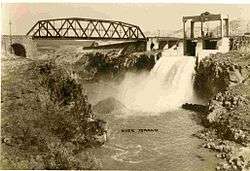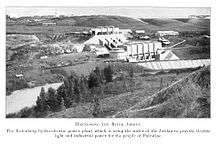Naharayim



Naharayim (Hebrew: נהריים literally "Two rivers") or Baqoura (Arabic: الباقورة) is a site on the border between Israel and Jordan where the Yarmouk River flows into the Jordan River. An hydroelectric power-plant had operated at Naharayim from 1932.[1] The plant, established by Pinhas Rutenberg, produced much of the energy consumed in the Mandatory Palestine until the 1948 Palestine war. The canals and dams built for the power-plant created a man-made island.
History

Pinhas Rutenberg, a Russian-born Zionist and engineer immigrated to Palestine in 1919. After submitting a plan to the Zionist movement for the establishment of 13 hydroelectric power stations and securing financing for the plan, he was awarded a concession from the British Mandatory government to generate electricity, first from the Yarkon River near Tel Aviv, and shortly thereafter, utilizing all the running water in western Palestine.[2]
The Naharayim site was chosen for the strong water flow and the possibility of regulating the flow through storage in the Sea of Galilee during the winter rainy season and release of the water reserves in the summer. Construction began in 1927 and continued for five years, providing employment for 3,000 workers. The site was named Naharayim, Hebrew for "Two Rivers."[2]
Tel Or (Hill of Light) was a residential neighborhood built near the plant to house employees.[3] Employees of the power station also farmed thousands of dunams of land and sold some of the produce at a company workers’ supermarket in Haifa. [4]
In the days before Israeli independence, Naharayim was the proposed venue for two meetings between Golda Meir and king Abdullah, in an attempt by the Jewish leadership to head off Jordanian participation in the war.
In violation of international law and a November 1947 agreement between Meir and Abdullah, the Arab Legion's 4th Battalion launched a mortar and artillery attack on the Naharayim police fort and Kibbutz Gesher on April 27-29, 1948. The attack paved the way for the pan-Arab invasion of Mandatory Palestine. On the evening of April 27, the Legion began shelling the fort and kibbutz, stepping up the attack the following day. Many of the kibbutz buildings were destroyed.[5]
On the morning of April 29, a Legion officer demanded the evacuation of the fort, but was turned down. After protests to the British Mandate administration, the shelling was halted, and Abdullah was reprimanded for "aggression against Palestine territory."[6] In the wake of the attack 50 children of the kibbutz were evacuated, first to the Ravitz Hotel on the Carmel,[7] and then to a 19th-century French monastery on the grounds of Rambam Hospital in the Bat Galim neighborhood of Haifa, where they lived for the next 22 months.[8]
An Iraqi brigade invaded at Naharayim on May 15, 1948, in an unsuccessful attempt to take the kibbutz and fort.[9] The power plant was occupied and looted by the Iraqi forces.[10]
To prevent Iraqi tanks from attacking Jewish villages in the Jordan Valley, the sluice gates of the Degania dam were opened. The rush of water, which deepened the river at this spot, was instrumental in blocking the Iraqi-Jordanian incursion.[2]
Peace park
The remains of the power station are part of the Jordan River Peace Park on the Island of Peace on the Israel-Jordan border.[11] The project is spearheaded by the trilateral NGO EcoPeace Middle East, headquartered in Tel Aviv, Bethlehem and Amman.
References
| Wikimedia Commons has media related to Naharayim. |
| Wikimedia Commons has media related to Jisr el Majamieh. |
- ↑ Naharayim - What a rush at the Wayback Machine (archived February 27, 2012)
- 1 2 3 Avitzur, Shmuel (2003-05-22). "The Power Plant on Two Rivers". Israel Ministry of Foreign Affairs. Retrieved 2009-09-03.
- ↑ Encyclopedia of Zionism and Israel, ed. Raphael Patai, Herzl Press/McGraw Hill, New York, Vol. 2, p.818
- ↑ The Humble Beginnings of Israel Electric Corporation, Revealed
- ↑ The Road to Jerusalem: Glubb Pasha, Palestine and the Jews, Benny Morris
- ↑ The Road to Jerusalem: Glubb Pasha, Palestine and the Jews, Benny Morris
- ↑ The Outsider Haaretz
- ↑ 70th anniversary, Rambam Hospital
- ↑ The Road to Jerusalem: Glubb Pasha, Palestine and the Jews
- ↑ Jewish-Transjordanian Relations 1921-1948, Yoav Gelber
- ↑ Projects - Jordan River Peace Park foeme.org
Coordinates: 32°38′39.83″N 35°34′22.26″E / 32.6443972°N 35.5728500°E